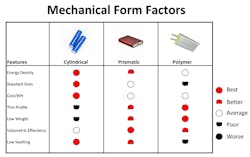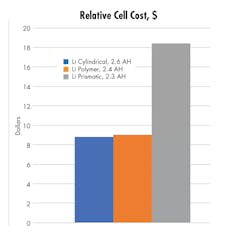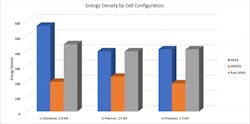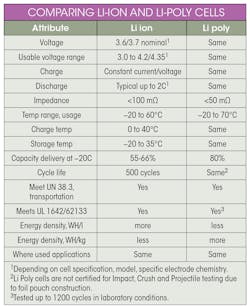Rechargeable lithium batteries come in a variety of configurations, physical sizes, and capacity ratings. There are three basic configurations within the industry for lithium chemistry. The first are round configurations similar to small barrels, known as cylindrical cells/batteries. Typical sizes are 18 × 65 mm, 21 × 50 mm, and 26 × 65 mm. The next common configurations are flat and rectangular, similar to small boxes, known as prismatic cells. Typical sizes are 5 × 34 × 50 mm and 10 × 34 × 50 mm, along with a variety other standard sizes.
The third configuration is flat foil pouches very similar to chewing-gum packages, generally known as lithium-polymer cells/batteries. Typical sizes are per prismatic cells, but a wide variety of additional sizes abound within the marketplace.
Industry verbiage typically refers to cylindrical and prismatic cells as being “traditional” Li ion and pouch cells as being “Li polymer” or “Li poly” or “pouch” batteries. For the purposes of this article, we will use Li ion for traditional cells and Li poly for pouch nomenclature.
The Manufacturing Side
Manufacturing of traditional Li ion versus Li poly is vastly different. For Li ion, a vast array of expensive automated equipment and tooling is required to produce the cells. The cylindrical cell configuration has become the workhorse of the industry, being the most commonly used in a large variety of applications. It’s also where the most technology advances are made as rechargeable Li chemistry technology matures.
Manufacturing of prismatic cells also requires intensive capital equipment expenditures. However, there have been fewer, and smaller, technology advances in the prismatic cell/battery arena. From a manufacturing perspective, cylindrical cells are the least expensive to manufacture, followed by prismatic configurations.
It’s a different case with Li poly cells. Being a pouch cell, tooling and equipment is less expensive for manufacture. Overall investment in setting up a cell assembly process also is less costly. Manufacturing a Li-poly foil pouch is much less intensive than a traditional Li-ion “can” cell. And, since overall tooling and equipment costs are much lower, a designer has a larger variety of pouch-cell sizes to choose from. The Li-poly construction allows for odd shapes and even bendable batteries to be manufactured. A Li Poly battery can be designed and developed that will encompass all of the internal space within a given battery envelope; this equates to offering the maximum amount of achievable capacity within a battery pack.
Comparable Chemistries
From a chemistry perspective, traditional Li ion is the same/similar to Li poly. Both have various formulations for improved life, energy density, safety, and overall performance characteristics. All reputable manufacturers of Li-ion and Li-poly cells undergo a series of certification testing to confirm safety of design and manufacturing. These tests are defined as UL 1642 and UL 62133. Within these standards, cells are subjected to short circuit, temperature shock, low pressure, abnormal charging, forced discharge, crush, impact, shock, vibration, heating, and projectile testing.
However, for Li-poly cells, compliance exceptions exist due to the foil-pouch configuration. With the absence of a metal structure, the specific requirements for crush, impact, and projectile aren’t considered. This doesn’t imply Li polymer isn’t as safe as a traditional Li-ion product; it just means current test methods can’t be applied to a pouch product.
With no supporting exo-structure surrounding the internal active materials, a battery pack using Li-poly cells must be constructed differently than traditional Li ion. The cells must be secured or unitized in a manner to prevent any movement within the battery pack.
Traditional Li ion uses a metal can as the enclosure, providing external support. However, this sealed metal can may act as a pressure vessel during abusive conditions. Although the cell design usually contains a vent mechanism, the vent can’t always operate quickly enough during catastrophic events to prevent total rupture of the can. For Li poly, the foil pouch doesn’t have a vent mechanism, so it can’t contain internal pressure buildup either. The pouch seams will usually rupture and vent any excessive pressure. See the table for a comparison between the two chemistries.
Use of cylindrical cells may not provide the highest capacity since all the internal space within the battery compartment (or plastic housing) is not utilized (voids of the cylindrical shapes). Depending on real estate, prismatic and Li Poly cells can sometimes utilize all the available internal space within a battery pack. And specialty-sized Li Poly cells can be manufactured to completely fill the internal spacing. From a weight perspective, traditional can cells will weigh more than Li Poly within a given application due to the lighter weight of foil pouches.
In terms of environmental issues, all Li-ion and Li-poly cells/batteries need to be properly recycled, and should be disposed of in the normal waste stream. As with any battery, encouraging participation in a formal recycling program is recommended.
Is Li-Poly the Better Option?
In the end, Li-poly offers several advantages over Li-ion in portable applications:
- Very safe, benign system during charge and discharge, excellent thermal stability.
- Light weight, great power density.
- Better low-temperature performance, limited voltage depression, and higher capacity delivery.
- Less investment to manufacture in a larger variety of cell sizes.
- Battery real estate isn’t restricted to industrial cell sizes dictated by consumer uses and device applications; i.e., “Cell shape ideally fits the device it will power.”
- Excellent cycle life over commercial Li ion product.
- Product cost in many applications is equal to Li ion, but that’s highly dependent on battery configuration and volumes.
- Consumer markets are poised to use greater numbers of Li-poly cells over Li ion due to form factor, less weight, greater energy density, safety, consumer security, and flexible assembly into devices.
- Well-accepted as an alternative to Li ion.
Use of traditional Li ion in cylindrical or prismatic forms versus use of Li polymer provides greater choices to the battery designer. Many factors come into play but ultimately, if applied correctly; the battery product will provide many years of safe performance to the user.





